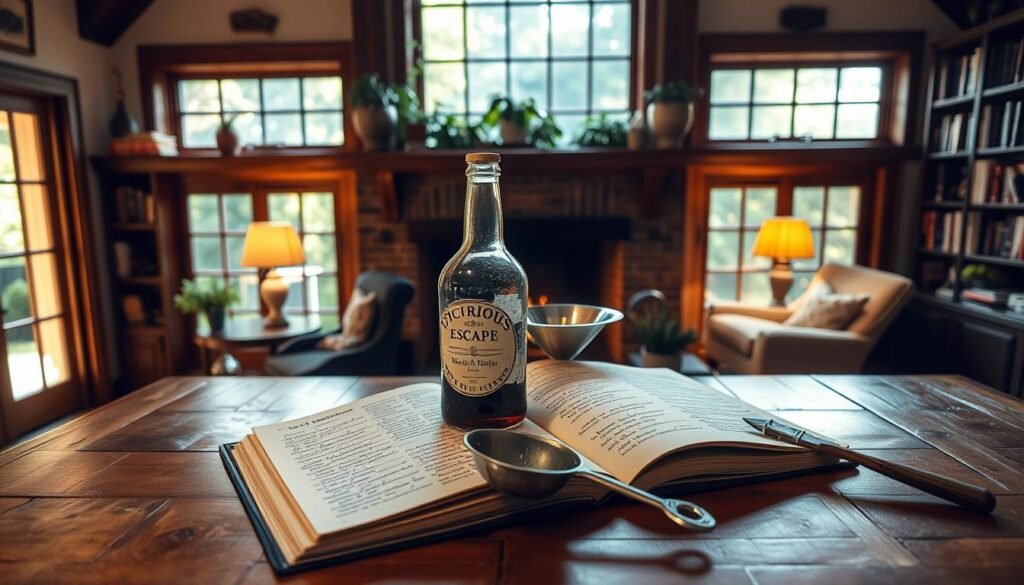I’m excited to share my journey in extract brewing with you. It’s a great way to start making tasty beers. It’s easy because you don’t need a lot of special equipment. You can make many beginner-friendly beer styles with it.
Extract brewing is simple, like making mac and cheese from a box. It’s perfect for those new to home brewing. This method is great because it makes flavors consistent and reduces off-flavors.
It’s also quick and easy, saving you time. Beginners love it because it’s simple and affordable. You can get everything you need in a beer recipe kit, making it even easier.
In extract brewing, we’ll find out about popular beer styles like American Pale Ale and Brown Ale. We’ll also learn what equipment you need and how to make great extract-based recipes. Whether you love food or are new to brewing, extract brewing is a fun way to make tasty beers and try new flavors.
Key Takeaways
- Extract brewing is a great way to start crafting delicious beers, especially for novice brewers.
- Extract brewing offers consistency in flavors and a lower potential for off-flavors.
- Extract brewing setups are generally more affordable than all-grain systems.
- A beer recipe kit can simplify the extract brewing process.
- Popular beer styles, such as American Pale Ale and Brown Ale, are perfect for extract brewing.
- Extract brewing allows for quicker batch production and is a time-saving method.
- Extract brewing is an excellent way to create delicious beers and experiment with new flavors.
Understanding Extract Brewing: Your Gateway to Homebrewing
Starting with homebrewing? It’s key to grasp the basics of extract brewing. This method uses malt extracts for a consistent, top-notch brew. It’s perfect for newbies because it’s easy and doesn’t need fancy gear.
Extract brewing is super convenient. You can start brewing in about 30 minutes. The whole process takes around 2 weeks. It’s also cheaper than buying beer, making it a great choice for beginners.
There are two types of malt extracts: liquid and dry. Each has its own perks and downsides. Liquid extracts are easier to use, while dry extracts last longer and don’t spoil easily.
In summary, extract brewing is a great starting point for homebrewing. It’s easy, convenient, and budget-friendly. Learning about extract brewing and malt extracts will help you make tasty brews.
Essential Equipment for Extract Brewing Success
Exploring extract brewing, I’ve learned that the right gear is key. The equipment, like brew kettles and fermenters, is vital for making great beer. A stainless steel brew kettle is best because it’s tough and easy to clean.
A good setup includes a fermenter, where the magic happens. A 6.5-gallon fermenter is a good start. It’s important to pick a fermenter made for extract brewing for the best results. The Brew Share Enjoy kit, for example, comes with a 6.5-gallon fermenter and a new lid.
Other must-haves are a hydrometer, thermometer, and sanitizer. The hydrometer checks the beer’s gravity. The thermometer keeps the fermentation temperature right. Sanitizer keeps the beer clean, preventing contamination. With the right equipment, you’ll make beer that’s sure to please.
Mastering Extract-based Recipes for Novice Brewers
As a novice brewer, learning extract-based recipes is key to making great beers. It’s important to know how to read and use these recipes. This includes figuring out measurements and making changes to taste.
Working with extract recipes means understanding the type of extract used. Liquid malt extract makes beers smooth and full-bodied. Dry malt extract gives beers a crisp, hoppy taste. Knowing these differences helps brewers make a variety of beers.
Let’s look at a basic extract recipe and how to tweak it. Here are some important points:
- Choose a high-quality extract that fits your beer style
- Calculate the right amounts of extract and water
- Make changes to taste, like adding more hops or changing yeast

By following these tips and trying different recipes, novice brewers can improve. They can make everything from classic pale ales to complex stouts. Mastering extract-based recipes is a big step in your brewing journey.
The Step-by-Step Extract Brewing Process
Exploring extract brewing means understanding its process. This guide will show you how to make your ideal beer. The steps include steeping, boiling, and fermenting. First, steep your specialty grains in hot water to get flavors and sugars.
Steeping involves soaking grains in water at 160°F (71°C) for 30 minutes. Then, boil the mix with malt extracts to make the wort. This step is crucial for your beer’s taste and character. Cool the wort to 70°F (21°C) before fermentation.
Fermentation takes about a week, followed by another week for secondary fermentation. Keep the fermentation temperature as the yeast package suggests. After, bottle your beer, leaving an inch for carbonation. When bottling, siphon the beer, leaving sediment behind.
- Steeping: Soak specialty grains in hot water to extract flavors and sugars.
- Boiling: Boil the mixture with malt extracts to create the wort.
- Fermenting: Allow the wort to ferment, converting the sugars into alcohol.
- Bottling: Bottle the beer, leaving space for carbonation.
By following this guide, you’re on your way to brewing your perfect beer.
Popular Beer Styles Perfect for Extract Brewing
Exploring extract brewing opens up a world of beer styles. I’m excited to share what I’ve found. From American Pale Ale to Brown Ale, many styles can be mastered with extract recipes.
Extract brewing lets you make a wide range of beers, even the tricky ones. For instance, American Pale Ale is easy to brew with extracts. It results in a balanced beer with a nice hop flavor. Brown Ale is also a breeze to make with extracts, offering a rich, malty taste and a smooth finish.

The secret to success in extract brewing is knowing your extracts. By trying out different styles like American Pale Ale and Brown Ale, brewers can hone their skills. This way, they can craft unique, tasty beers that show off their talent.
Some top extract beer styles include:
- American Pale Ale: a balanced beer with a hint of hoppiness
- Brown Ale: a rich, malty beer with a smooth finish
- Simple Stout: a dark, roasted beer with a creamy texture
Mastering extract recipes and trying out various styles opens up endless possibilities. Whether you’re new to brewing or have experience, extract brewing is a great way to explore and improve your skills.
Common Extract Brewing Mistakes and Solutions
Exploring extract brewing, I’ve found that even with top-notch gear and methods, errors can occur. Extract brewing mistakes can be upsetting, but knowing common errors helps us brew better. A common issue is over- or under-extracting, which greatly affects the beer’s taste and quality.
To sidestep these errors, it’s crucial to stir well when adding malt extract and to warm liquid malt extract first. Also, using the correct amount of hops and yeast is vital for a great beer.
Some frequent mistakes include:
- Not sanitizing enough, leading to contamination and bad tastes
- Not controlling temperature well, which can mess up fermentation and taste
- Getting hopping rates wrong, causing unbalanced flavors
Knowing thesecommon errors and how to avoid them helps extract brewers make better beer. This makes brewing more enjoyable and rewarding.
Enhancing Your Extract Brews with Specialty Ingredients
Exploring the world of extract brewing is exciting. I’m eager to see how specialty ingredients can improve my brews. With over 30 years of brewing at home, I’ve found that the right mix of ingredients can make a big difference. Ingredients like unique grains and hops can add depth to my beers.
Extract brewing is quicker than all-grain brewing. This means I can try more and learn faster. It’s perfect for beginners because it helps develop flavors and styles. I can try different yeast strains to make everything from crisp lagers to rich ales.
Here are some specialty ingredients to try:
- Specialty grains, such as wheat or rye, to add unique flavors and textures
- Various hops, including aroma and bittering varieties, to create complex flavor profiles
- Different yeast strains, such as ale or lager yeast, to produce distinct beer styles

Using these ingredients, I can make a variety of tasty and unique beers. With time and effort, I can perfect my brewing skills. This way, I can create my own special beers while enjoying the brewing process.
Quality Control and Storage Tips
As a homebrewer, I know how important quality control and storage are. Keeping ingredients fresh, watching fermentation, and storing beer right are key. These storage tips help avoid contamination and spoilage, making your beer taste better.
Watching over fermentation monitoring is crucial. You need to track temperature, gravity, and more. This helps spot problems early and fix them. Also, a quality control system can catch any issues, helping you improve your beer.
- Storing ingredients in a cool, dry place to prevent spoilage
- Monitoring fermentation temperature and gravity to ensure a healthy fermentation
- Using proper sanitation and cleaning techniques to prevent contamination
- Storing brewed beer in a cool, dark place to prevent degradation
By sticking to these storage tips and using a strong quality control system, your beer will be top-notch. Always keep an eye on fermentation monitoring and fix any problems you find.
Ready to Brew: Your Journey Starts Here
Congratulations on finishing our guide to extract brewing! You now know the basics, from recipes to beginner-friendly beers. Your journey as a homebrewer is just starting, and we’re excited for you.
You’re ready to dive into extract brewing with the knowledge we’ve shared. Always keep sanitation and fermentation in mind. Don’t be shy to try new ingredients and methods. Your brewing journey is a chance to explore and create unique beers.
So, what are you waiting for? Get your brewing gear, pick a tasty recipe, and start brewing. You can make everything from American Pale Ales to rich Stouts. Enjoy the process, celebrate your successes, and have fun. Cheers to your homebrewing journey!

